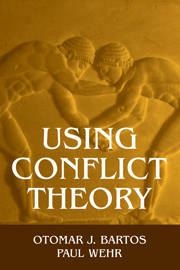Book contents
- Frontmatter
- Contents
- List of Figures and Tables
- Acknowledgments
- 1 Introduction
- 2 Understanding Conflict
- 3 Development of Incompatible Goals
- 4 Application to the Civil Rights Struggle
- 5 Emergence of Overt Conflicts
- 6 Application to a University Conflict
- 7 Escalation and Deescalation
- 8 Application to Conflict in Bosnia
- 9 Making Conflict Work Economically
- 10 Understanding and Managing Conflicts
- Appendix: Prelude to the Dissolution of Yugoslavia
- Notes
- References
- Index
8 - Application to Conflict in Bosnia
Published online by Cambridge University Press: 05 June 2012
- Frontmatter
- Contents
- List of Figures and Tables
- Acknowledgments
- 1 Introduction
- 2 Understanding Conflict
- 3 Development of Incompatible Goals
- 4 Application to the Civil Rights Struggle
- 5 Emergence of Overt Conflicts
- 6 Application to a University Conflict
- 7 Escalation and Deescalation
- 8 Application to Conflict in Bosnia
- 9 Making Conflict Work Economically
- 10 Understanding and Managing Conflicts
- Appendix: Prelude to the Dissolution of Yugoslavia
- Notes
- References
- Index
Summary
in the preceding chapter, we suggested how conflict, once it has emerged, can intensify through escalation. We saw how various factors can make conflict parties more hostile, more retaliatory, and less willing to curb coerciveness, thus leading to escalation. There is hardly a better contemporary real-world illustration of this process than the Bosnian civil war of the 1990s. In this chapter, we apply our theory of escalation to that case. We thereby add a cross-national illustration to the intraorganizational and intrasocietal cases used in earlier chapters.
The Bosnian Conflict
The origins of the Bosnian conflict are more complex than we have space to explore here. However, we do present an account of its post–World War II roots for the reader in the Appendix, “Prelude to the Dissolution of Yugoslavia.” Here we present only the historical background immediately preceding the escalation of the conflict, the central concern of the chapter.
As the Bosnian civil war developed from 1991 to 1995, four main conflict groups were involved. Group 1 comprised the government of the Republic of Croatia (Zagreb) and the Croat minority in Bosnia. When those two acted together, as was usually the case, we refer to them as “Croats.” Group 2, the government of the Bosnian republic and its forces, was very much a multiethnic body in 1991 but by 1995 had become mostly Muslim. We refer to this group as the “Bosnian government,” because an independent, multiethnic Bosnia was its intention.
- Type
- Chapter
- Information
- Using Conflict Theory , pp. 122 - 147Publisher: Cambridge University PressPrint publication year: 2002



